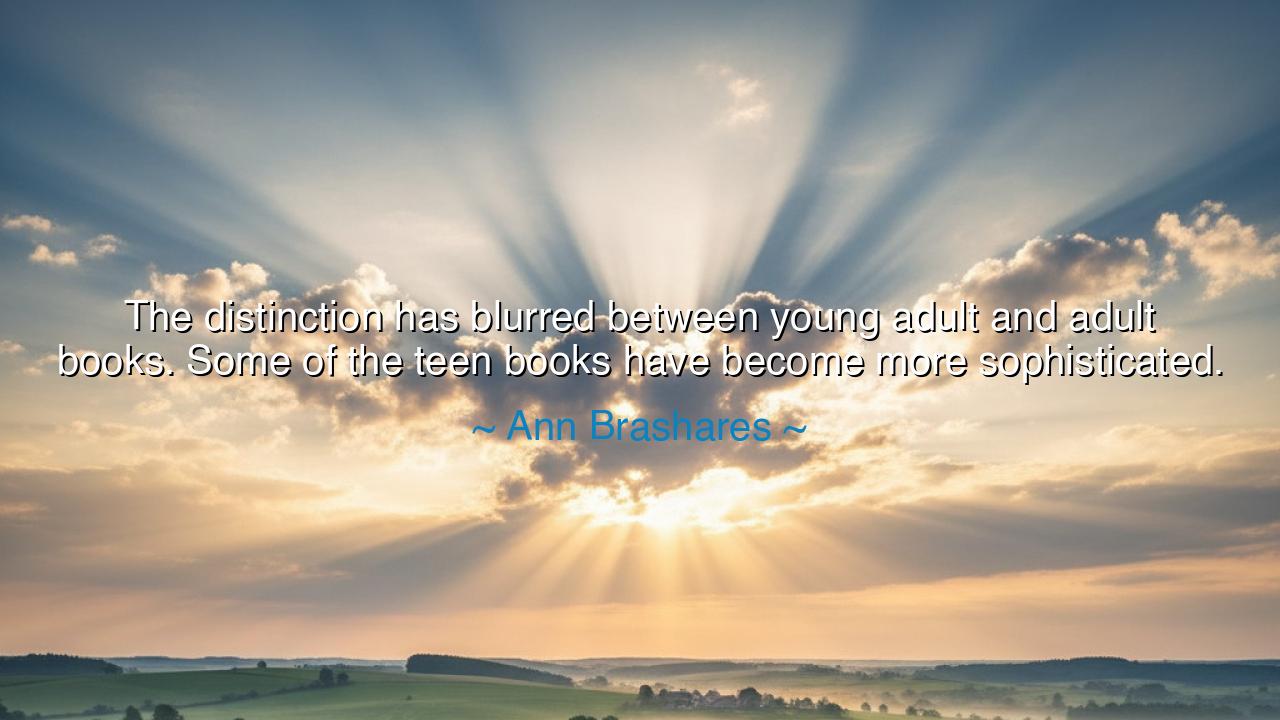
The distinction has blurred between young adult and adult books.
The distinction has blurred between young adult and adult books. Some of the teen books have become more sophisticated.






When Ann Brashares observed, “The distinction has blurred between young adult and adult books. Some of the teen books have become more sophisticated,” she revealed a truth about the shifting nature of storytelling across generations. Her words speak to the evolution of literature, to the way tales once dismissed as mere entertainment for youth have risen in depth, power, and meaning. In her insight, we hear the call to honor teen books not as lesser companions to adult works, but as vessels capable of carrying weighty truths, profound themes, and timeless wisdom.
The origin of this thought comes from Brashares’ own work as the author of The Sisterhood of the Traveling Pants, a story written for young readers yet cherished by audiences far beyond adolescence. She saw firsthand that the struggles of friendship, love, and identity explored in young adult fiction resonated deeply with readers of all ages. Over time, the line dividing what is “for teens” and what is “for adults” grew faint, for the human heart does not recognize such divisions. The same emotions—fear, longing, joy, despair—burn in the young and the old alike.
History itself affirms this truth. The ancient epics, such as Homer’s Odyssey, were recited to entire communities, from the young to the aged, binding generations together in shared story. No one asked if it was “appropriate for teens” or “too simple for adults”—for the tale itself contained layers, offering delight to the child and wisdom to the elder. In the same way, many modern teen books, though born for younger audiences, now carry sophistication that speaks to every stage of life. Stories like Harry Potter or The Hunger Games are not confined to one age group; they echo universal struggles of morality, freedom, and belonging.
There is also within Brashares’ words an affirmation of growth within the genre itself. Once, “teen books” were often seen as trivial, light, or shallow, mere diversions before “serious” reading began. But now, many such works confront issues of injustice, identity, grief, and love with a courage even adult fiction sometimes avoids. This sophistication reflects not only the growth of writers, but also the rising respect for young readers, who are recognized as capable of grappling with truth. The once-rigid boundary has dissolved, because wisdom is not confined by age.
The deeper meaning here is that stories are bridges between generations. The blurred distinction is not a loss but a gain, for it allows parents and children, teachers and students, friends of all ages to share the same stories and find in them shared truths. A tale written for the teen may awaken nostalgia in the adult; a tale written with complexity may sharpen the mind of the youth. Thus, in this blurring, we see unity—the reminder that the thirst for meaning belongs to all souls, regardless of age.
The lesson is simple yet profound: do not dismiss a book because it is labeled for the young, nor assume depth is found only in works meant for adults. Approach every story with an open heart, and let it speak to you where you are. For often, the wisdom wrapped in the simplicity of youth can pierce deeper than the most elaborate adult tale. The sophistication of teen books teaches us that truth wears many disguises, and sometimes the plainest words carry the greatest fire.
Practical counsel flows: read across ages. If you are an adult, take up a story written for the young and allow it to remind you of your first struggles with identity and hope. If you are young, do not fear the so-called “adult” books, for they too are yours to inherit. Writers, take heart: do not water down your stories for youth, but trust them to carry depth and complexity. Readers, cherish every tale that resonates, no matter the label.
Thus let Ann Brashares’ words endure as a teaching: the boundary between youth and age is an illusion, and stories belong to all who hunger for them. Read deeply, across all divides, and you will find that in every book—whether meant for teen or adult—there beats the same eternal heart of humanity.






AAdministratorAdministrator
Welcome, honored guests. Please leave a comment, we will respond soon